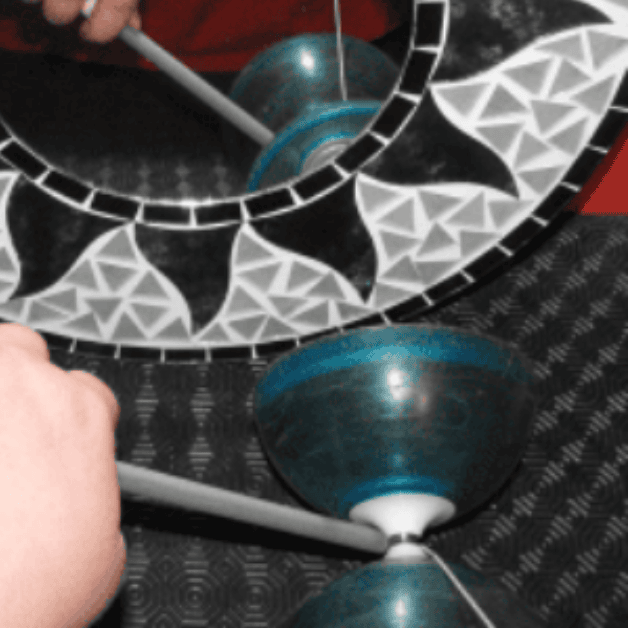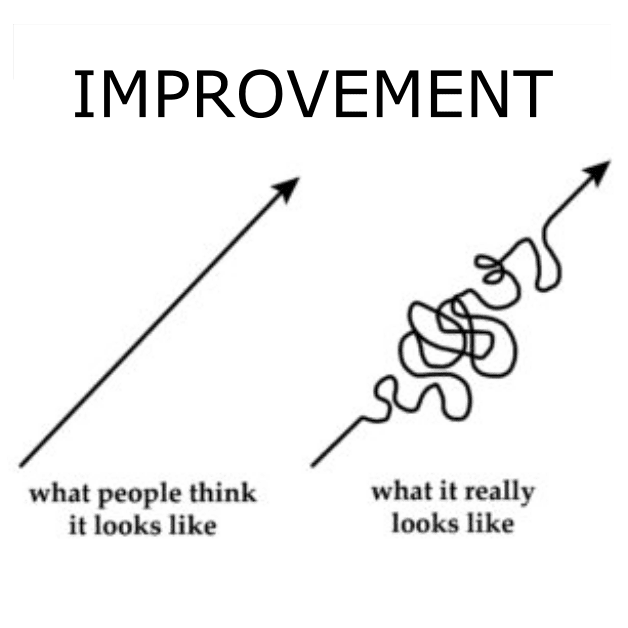1. Things To Consider First
Are you a righty or a lefty?
Diabolo is the only juggling prop where hand dominance matters because all tricks require the diabolo to spin.

In my opinion, you need to learn diabolo according to your hand dominance. It will be more challenging for lefties as the majority of tutorials (including the ones found on this website) describe and illustrate the tricks for right handers. But as left handed jugglers learn to “translate” the tutorials (switching right for left and vice versa), they will find it easier to learn tricks the lefty way.
For more tips on how to learn diabolo if you are left handed, you can find a useful article here.
Gear
Let’s start with the bad news: there is no ultimate gear that will make you a better diabolo player.
But the good news is if you have decent sticks, string and diabolos, you can learn every trick under the sun. Any big diabolo, sticks and string from any good diabolo brand (Henry’s, Sundia, Taibolo, …) will be good.
Don’t fall into the trap of changing gear when you’re not improving. The reason for a plateau is not the diabolo or sticks, it’s most likely the difficulty of the tricks you’re trying to learn.
You can find more information on how to choose a good diabolo, pair of sticks and string by clicking the links.
Outfit
As for any physical activity, you’ll need a comfortable outfit that doesn’t hinder your movements.
But for diabolo juggling there is more to consider:
- avoid long and loose sleeves as the sticks tend to get caught in them which will make you mess up
- tight long sleeves are better as they protect your wrists from string burn
- you may also want to protect other areas from string burn such as your neck and legs
2. How To Train
The structure of your juggling session
If you want to improve as fast as possible, the best way,in my opinion, to practice is

1. Short Warm Up
The warm up is optional if the trick you’re practicing is low intensity with 1 diabolo and little body movement. However, if you’re aiming at a more intense trick, you need to warm up to avoid injuries.
Focus on your wrists and any body part that you will use (neck for high siteswaps, back and legs for body moves, …).
Keep the warm up short so you can keep your energy and focus on learning the trick you’re working on.
2. Practice The Trick You Are Trying To Learn
Mastering a new trick is challenging. That’s why you need all the focus and energy you can get.
At the end of a juggling session, you will have a harder time with difficult tricks because of tiredness and loss of focus. That’s why it’s best to jump in straight away to take advantage of your peak energy.
Researchers found that mild to moderate muscle fatigue causes poorer practice performance, but does not affect learning, but high muscle fatigue will impair learning.
( Lawther, J.D.,”The Learning and Performance of Physical Skills,” Second Edition, Prentice-Hall Inc., Englewood Cliffs, N.J.,1977.)
So train as long as you can because, even if you are slightly tired and start dropping, you will still improve.
However stop practicing the new challenging trick when your energy is depleted so you don’t develop bad habits and slow your progress in the long term.
3. Mess Around Or Stop
Because extreme muscle fatigue impairs learning, it’s best to do the tricks you already know or stop juggling when it happens.
If you want to continue juggling when your energy is very low, just mess around with the tricks that are already part of your repertoire.
The good thing about high fatigue is you will most likely come up with new ideas for a variation of a trick or a way to link tricks together and create a new combo. My best creative ideas happened in this part of the juggling session.
Keep A Juggling Log
I find that keeping a diabolo log helps me improve a lot.
I have a list of tricks I want to work on, I record my creative ideas and keep a journal of my practice sessions.
It helps me keep motivated when I look back on my progress, when I don’t know what to practice next, I refer back to the list of tricks I want to learn and find one that I’m ready for or I look at my ideas log.
I also have an article on the importance of keeping a juggling log.
Training Consistency
The frequency of your practice sessions is more important than their duration.
It’s better to juggle a little bit every day rather than to have a massive practice session once a week.
You will have more high energy time overall with multiple shorter sessions therefore you will be able to spend more time practicing hard tricks and will improve faster.
It will also help avoiding injuries by building calluses and not have nasty blisters, preventing tendinitis from overusing your wrists, elbows and shoulders. No injuries mean you can train more and more efficiently and you’ll be able to make more progress.
Where To Train
Different diabolo tricks require a different amount of space. You will only need about a meter (3 to 4 feet) around you and a low ceiling for some tricks (for example, 2D sprinkler or 1D mini-genocide). You’ll need more space around you for body tricks and vertax. And you’ll need a high ceiling for big stick releases and diabolo high or feed the suns tricks.
Make sure you have enough space to practice the tricks you want to work on. One way of doing that is to juggle outside, but outdoor diabolo comes with its own set of drawbacks : wet weather will wear your string out and you will need to change it more, the wind can be hard to work with, tilting your diabolos or pushing them out of alignment, this is especially true if you have lighter diabolos, and the cold can hurt your hands when you catch sticks (the aluminum sticks are the worst in cold weather).
For more detailed information on what to practice where, you can go to this article.
Injuries
Diabolo is not a dangerous hobby, It is a plastic toy suitable for children from the age of 5, but injuries can happen.

The 3 main “dangers” of diabolo are:
1. Tendinitis
If you are right-handed, it will affect your right wrist, elbow or shoulder. If you are left-handed, the left side will be affected.
This only happens when you train too much for weeks on end and is easily avoidable. At the first sign of discomfort, STOP! I said discomfort, not pain. If you feel pain, it’s too late and you’ll need to see a doctor and stop any training for several weeks until it goes away.
Slow and steady wins the race! The funny thing is you will improve faster with short, regular training sessions.
2. Blisters
This too happens when you overtrain, but mostly with wooden sticks. If you have sticks with foam or silicon handles like in carbon sticks or aluminum sticks, you are pretty safe ( you would have to overtrain so much that the tendinitis would stop you first).
If you only have wooden sticks, you can also buy devil stick handsticks, they come with a silicon grip that you can cut to the length you want and fit on your wooden sticks.
Here too, slow and steady is the answer, you will naturally develop callusses that will protect your hands.
3. String burns
This injury is painful and will leave a scar. It happens when the string is on your skin and is pulled quickly with force. The main areas victim to the string burn are your arms, wrists and neck. The solution is easy: wear long sleeves when you learn around the arm tricks and a hoodie when you learn around the neck tricks. When these type of tricks are mastered, you won’t risk burning yourself anymore.
So if you don’t overdo it and wear appropriate clothing when learning new tricks, you will be safe!
3. Choosing the tricks to work on
In Which Order Do You Learn Tricks?
There isn’t one right order to learn diabolo tricks, but most (if not all) tricks have prerequisites.
Let’s imagine you are a total beginner who only knows how to accelerate the diabolo and you want to learn the mini-genocide.
If you try it straight away, you will spend countless hours trying to do it and you might give up thinking this is impossible and you need to be talented to do diabolo.
But the mini-genocide is a really easy and fast trick to learn if you have the prerequisites under your belt.
For this example, you need to be able to throw and catch the diabolo, then learn to catch the diabolo in darkside, learn the suicide, learn to wrap and unwrap your diabolo and then the slowcide and the genocide. Each of these steps, if taken in order, will only take minutes to learn (half an hour max). Let’s suppose you learn each step in 30 minutes (This is a worst case scenario, it will take way less time I promise), it will take you 3 hours to learn everything you need to unlock the mini-genocide in minutes.
On this website, you will find, in every tutorial, the tricks you need to learn in order to be able to master a trick quicker. And if you don’t know where to start, check out the diabolo trick roadmap.
When To Move On From The Trick You Are Learning?
It’s usually not necessary to completely master one trick before moving on to the next. I strongly believe that to improve quickly, you have to practice a new harder trick as soon as you have 80-90% consistency on your current trick.
My reasoning is, as you practice the harder trick, you will be working on the skills you need to master the easier one. If you want more information on the science, you can read on the concept of transfer of learning ( https://link.springer.com/chapter/10.1007/978-94-011-6279-1_9).
For example, imagine you can now throw and catch the diabolo without dropping 4 times out of 5, you can either bang your head against the wall and work on it until you have it 100% solid or you can try and learn another trick like :
- the orbit which requires you to throw and catch differently
- the suicide which will improve your string control (really important for the catching phase and for a multitude of other tricks)
- the elevator which will force you to master diabolo speed and diabolo speed is a must to keep your diabolo stable when throwing
4. Plateaus And How To Get Unstuck
Plateaus Don’t Mean You Are Not Improving
Almost everyone who has tried to learn a difficult trick has encountered a performance plateau. During this time it seems that your skill level is not improving at all, or even that you’re getting worse. Researchers have some good news for diabolo players! Your performance doesn’t reflect your improvement, at least not straight away.

Experiments have shown that while an individual’s performance may plateau or even get worse over the short term, the long-term rate of improvement is unaffected.
“Plateaus may appear during the course of practise, but it appears that learning is still going on; performance has plateaued, but learning continues.”
– Magill, R.A.,”Motor Learning: Concepts and Applications,” Third Edition, WCB Publishers, Dubuque, Iowa, 1989.
This suggests that it is still worthwhile to practise on “off days” when none of your hard tricks land and you keep dropping because your juggling skills will still improve.
Is The Trick Too Hard For Your Skill Level ?
If a trick seems much too difficult after several tries, you are probably not ready for it yet. You can check the Diabolo Trick Roadmap to make sure!
It’s better to practice something else (such as one of the prerequisites we talked about in part 3 of this article) or to practice an easier version of the trick in question.
There’s always a level you need to have before you learn a trick, but if you practice correctly, you will continue to improve.
The progress won’t always be as quick and easy as you would wish, like the 3 diabolo shuffle. You only need to know the 2D shuffle in one hand to learn 3D, but it will take months to get it and there’s no way around it.
Sometimes, little tweaks can help you get a trick faster. For example, having a shorter string that has some grip and starting with less diabolo speed will help with the infinite suicide.
Find Someone To Help You
Of course, the best way to get better at diabolo is juggling with friends.
Put yourself on the map linked below and find fellow diabolo players in your area.
https://umap.openstreetmap.de/en/map/diabolo-people_22104#4/50.64/34.75
Local juggling clubs are also a great place to get an outside perspective on what you’re doing wrong, and a place for more experienced diabolo players to help you with the next steps as you improve.
Juggling conventions are a great catalyst for improvement, these events are fun, inspiring and other diabolists will help you loads. Go to one as soon as you can !

If you don’t have anybody to juggle with in person, the next best thing is posting training clips to forums like /r/diabolo or FB groups like https://www.facebook.com/groups/690729387640517 a
If you are too shy to post on these group, you can always DM me on Instagram or contact me here.
Final Thoughts
You would need several life times to learn all the existing tricks (and more are created every day) ! The tricks you choose to learn should be based on what you want to learn and the few prerequisite tricks you need to master to unlock the ones you really want to perform.
But the good thing is, after you’ve learned the basic building blocks of diabolo, you can create your own tricks and develop your style. And if you’re not inspired, just learn an existing trick. The more tricks you learn the more tools you have to create.
I wish you a lot of joy on your diabolo journey! Have fun!



